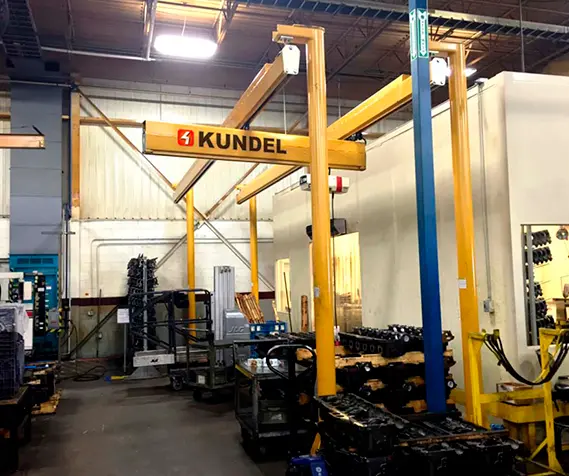Overhead cranes are essential pieces of equipment in many industries, providing the ability to lift and transport heavy loads with precision and efficiency. They come in various types, each designed to meet specific operational needs and environmental conditions. This blog explores the different types of overhead cranes, their unique features, and their applications.
1. Bridge Cranes
Single Girder Bridge Cranes
Single girder bridge cranes consist of a single bridge beam that spans the gap between two runways. The hoist and trolley run along this beam, making them ideal for lighter loads and smaller spaces. These cranes are often used in manufacturing and assembly lines, where quick and efficient material handling is required.
Advantages:
- Cost-effective for light to medium-duty applications
- Easier to install and maintain
- Lower headroom requirements
Double Girder Bridge Cranes
Double girder bridge cranes have two parallel bridge beams, providing greater strength and lifting capacity. They are suitable for heavy-duty applications and can handle larger loads and wider spans. Industries such as steel production, shipbuilding, and large-scale manufacturing commonly use these cranes.
Advantages:
- Higher load capacity
- Greater stability and durability
- Can accommodate higher hook heights and longer spans
2. Gantry Cranes
Gantry cranes are similar to bridge cranes but are supported by legs that move on wheels or along a track. These cranes are versatile and can be used both indoors and outdoors.
Full Gantry Cranes
Full gantry cranes have legs on both sides, allowing the entire structure to move along a track. They are commonly used in shipyards, rail yards, and construction sites, where large loads need to be moved over considerable distances.
Advantages:
- Suitable for heavy and bulky loads
- Can be used outdoors and in open spaces
- Provides a high degree of mobility
Semi-Gantry Cranes
Semi-gantry cranes have one leg that moves on a track on the floor, while the other side is supported by a runway attached to a wall or building. This design is useful in areas with limited space.
Advantages:
- Efficient use of space
- Cost-effective for medium-duty applications
- Flexibility in indoor and outdoor use
Portable Gantry Cranes
Portable gantry cranes are smaller, mobile versions that can be easily moved and adjusted. They are ideal for maintenance and repair tasks, allowing quick and temporary lifting solutions.
Advantages:
- Highly mobile and versatile
- Easy to set up and dismantle
- Cost-effective for short-term use
3. Monorail Cranes
Monorail cranes run on a single rail system, typically fixed to the ceiling. These cranes are perfect for production lines and areas where loads need to be moved along a specific path.
Advantages:
- Efficient for linear workflows
- Space-saving design
- Ideal for repetitive tasks in manufacturing
4. Jib Cranes
Jib cranes have a horizontal arm (jib) that supports a hoist. They are commonly used for localized lifting tasks and can be either floor-mounted or wall-mounted.
Free-Standing Jib Cranes
Free-standing jib cranes are typically mounted on the floor and can be fixed or rotate up to 360 degrees, providing a wide range of motion. Unlike traditional free-standing jib cranes, Kundel provides patented foundationless pod systems. They are used in workshops, warehouses, and docks.
Advantages:
- Independent operation without structural support
- Small footprint to work around your existing equipment
- Jib Boom leveler system
- Multi-point adjustment system
- Festooning free system
Wall-Mounted Jib Cranes
Wall-mounted jib cranes are attached to a wall or a column and typically have a rotation range of 180 to 200 degrees. They are suitable for areas where floor space is limited.
Advantages:
- Space-efficient
- Easy to install
- Suitable for smaller loads
5. Workstation Cranes
Workstation cranes are designed for smaller loads and precise handling tasks. They are modular and can be easily customized to fit specific workflow requirements. These cranes are often used in manufacturing, assembly lines, and maintenance facilities.
Advantages:
- High precision and control
- Modular design allows customization
- Easy to install and maintain
6. Top Running Cranes
Top running cranes operate on rails mounted on the top of runway beams. This design provides maximum hook height and is suitable for heavy-duty applications in large industrial facilities.
Advantages:
- Higher load capacity
- Optimal use of vertical space
- Suitable for large spans and heavy loads
7. Under Running (Underslung) Cranes
Under running cranes operate on the bottom flange of runway beams. This design allows better utilization of headroom and is suitable for facilities with low ceilings.
Advantages:
- Better headroom utilization
- Can be integrated into existing structures
- Ideal for light to medium-duty applications
Choosing the Right Overhead Crane
Selecting the right type of overhead crane depends on several factors, including the nature of the loads, the working environment, and the specific operational requirements. Here are some key considerations:
- Load Capacity: Determine the maximum weight the crane needs to lift
- Span and Height: Consider the width of the area to be covered and the required lifting height
- Operating Environment: Assess whether the crane will be used indoors, outdoors, or in hazardous conditions
- Frequency of Use: Evaluate how often the crane will be used and the intensity of operations
- Space Constraints: Account for any limitations in the available space, including headroom and floor space
Conclusion
Overhead cranes play a critical role in various industries, offering efficient and safe lifting solutions for various applications. Understanding the different types of overhead cranes and their specific advantages can help businesses choose the right equipment for their needs, enhancing productivity and ensuring workplace safety. Whether it’s a single girder bridge crane for light manufacturing or a full gantry crane for heavy-duty outdoor work, there is an overhead crane solution for every lifting challenge. Contact us today to have a specialist help guide you in choosing the right crane for your needs!

